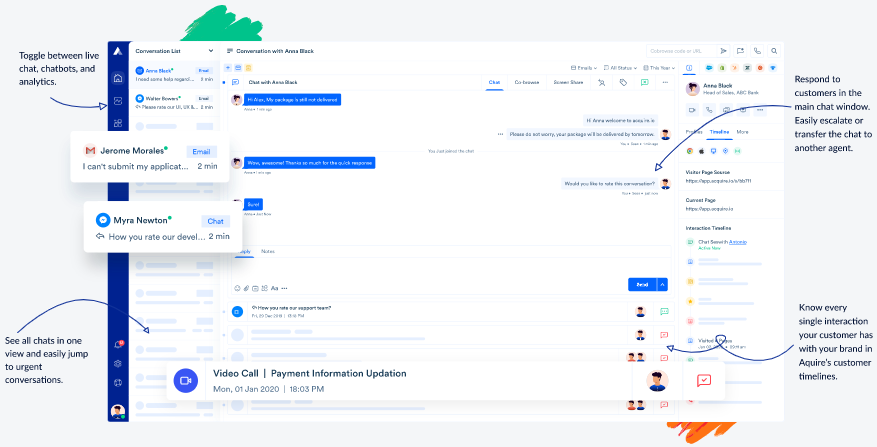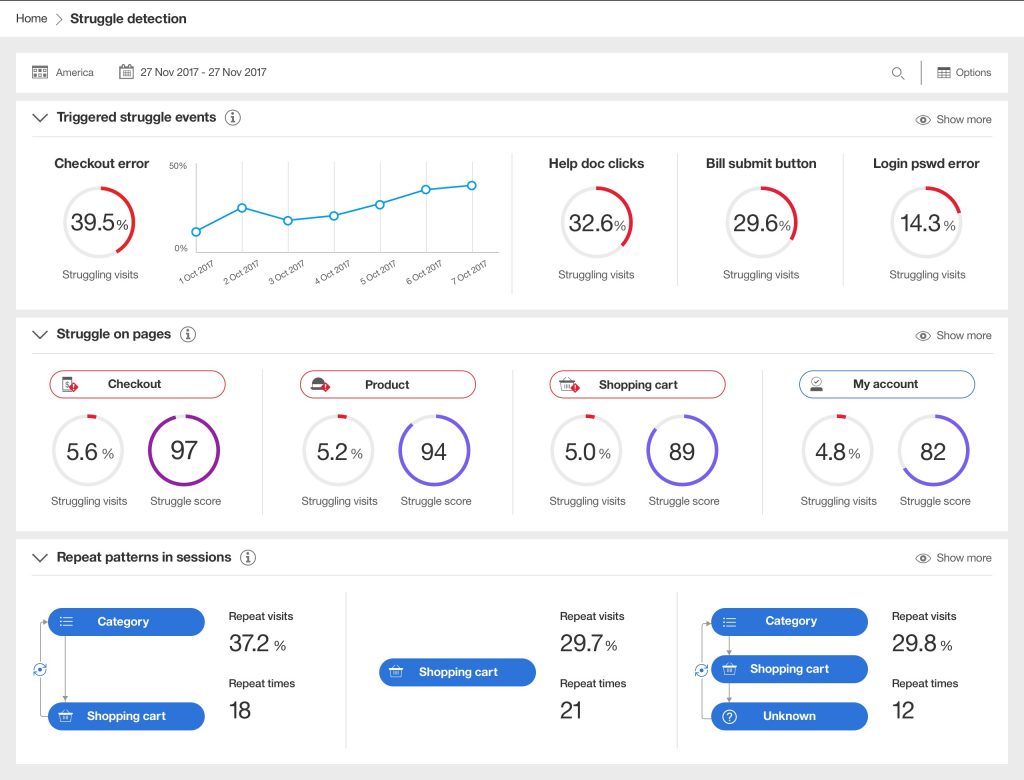Customer Analytics is a critical approach for identifying high-value customers based on their activity data. This enables businesses to choose which customer segments to prioritise. However, forecasting consumer behaviour and segmenting customers using predictive data analysis and data insights demands a lot from companies.
There is no way you can grow without really knowing your customers. Thriving competition would mean walking the extra mile to delight, keep, and attract customers. A lot, therefore, would depend on acquiring and evaluating relevant consumer data. This includes potential data set around social media attitudes, demographics, product feedback, preferences, interests, browsing information, and purchasing trends, among other things.
All such data is accessible, but how will your business use it to its fullest? The use of various customer analytics tools coupled with digital customer engagement software is critical in this situation.
When it comes to anticipating and understanding customers’ wants, customer analytics can be a huge asset for businesses. Making strategic and informed decisions is possible when you have the necessary insights.
Why is Customer Analytics important?
Any data that provides a peek into customer behaviour can provide useful insights to guide your analysis.
And for every step of the customer journey, your business needs to outperform the competition with an appropriate approach. For example, incorporating an interactive walkthrough for first-time customers and analysing their interaction with your software.
Such an approach based on customer behaviour helps develop better price strategies, advertising campaigns, and other management processes. Without a strong understanding of customer behaviour, your efforts could be utterly futile.
You can also employ predictive analytics to forecast client behaviour by blending in data from multiple communication channels. With customer analytics, you can get a 360-degree customer view, enabling a comprehensive understanding of customers. It helps evolve approaches for customer acquisition, retention, and proactive buyer engagement.
Key aspects of customer analytics
When we speak of customer analytics, we mean many elements that form a cohesive method that goes into analysing various aspects of customer behaviour. Here are the three main factors to consider when implementing customer analytics for your business.
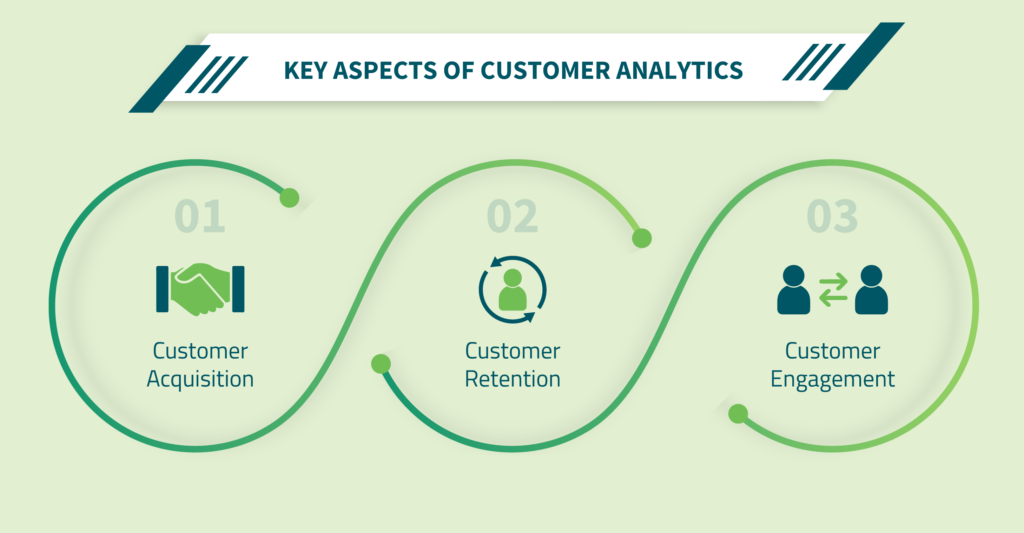
Customer Acquisition
Customer behaviour analysis helps craft efficient marketing and sales tactics tailored to the specific needs of each consumer. Focusing on the correct demographic can significantly minimise marketing costs as personalised marketing initiatives boost conversion rates.
Customer Retention
By analysing the “why” behind customer churn, you can start developing customer retention strategies to proactively engage at-risk customers to avoid future churn. The goal here is to offer personalised customer care and support to have them put faith in your business and engage further.
You can also incorporate a customer knowledge base that works as a self-service tool enabling them to quickly find answers to their questions along with how-to content on your products/services. The more they know about your brand, the more likely they are to make a purchase (again).
Customer Engagement
When it comes to successful consumer interaction, providing a helpful and personalised experience is critical. Customers appreciate customised solutions that are tailored to their specific needs. By researching their support requests and hurdles, you can interact with them more effectively. Customer experience metrics (such as NPS, CSAT, etc.) are quite beneficial in product uptake and fostering a positive rapport with your current set of customers.
Important Types of Customer Data You Should Consider
Typically, you may analyse four different forms of customer data that are available from different sources. Check these out and ensure you have them covered in your KPI list to unlock growth.
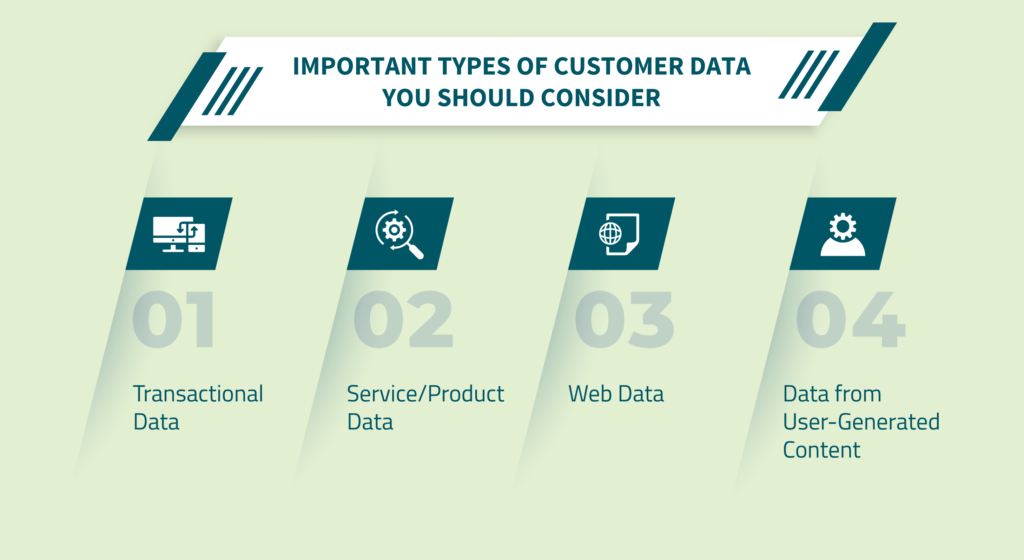
Transactional Data
Retail data is an excellent example of transactional data. Each transaction carries insight into the journey of the customer. For instance, Walmart crunches its previous transactional data to anticipate demand in the United States for around 500 million item-by-store combinations. This empowers them to stock necessary products at an appropriate location that boost sales.
Analysing transactional data will help you gauge demand-supply gaps and keep you ahead of the curve with customer requirements.
Service/Product Data
Product usage or service data can be analysed to improve the customer experience and drive innovation. For example, Toyota conducts several research initiatives focused on driver behaviour like image analysis to assess drivers’ head and hand positions. This also includes a database of numerous seating situations and seat belt settings to determine which enhancements would increase drivers’ comfort and safety.
If you are into the service business, you need to find out relevant metrics that impact the client experience. For instance, you can leverage contact centre solutions that help you with additional data to improve customer touchpoints with your business.
Web Data
Using Google Analytics enables you to understand your website’s performance and usage, such as from where they landed on your website, the pages they visited, and how long they stayed on each page. You may then create appropriate content based on such data to boost traffic and conversion rates.
Data from User-Generated Content
Customers often create content for your business, in the form of comments on social media, Google reviews, and product reviews on your platform. While they embrace the opportunity to express their thoughts, your business must analyse this information to understand your consumers’ opinions about your product, brand, or service, and tailor your product strategy to their feedback.
Try spotting a pattern and determine if customers have a good or negative emotional tone. Samsung, for example, uses social media monitoring to woo customers away from rivals.
A flowchart of the three key processes to set up a customer analytics framework
Modern customer experience efforts have greater weight and impact when all departments share the same attitude. By using a customer journey analytics framework to design those experiences, you ensure that your business has a uniform attitude across all departments.
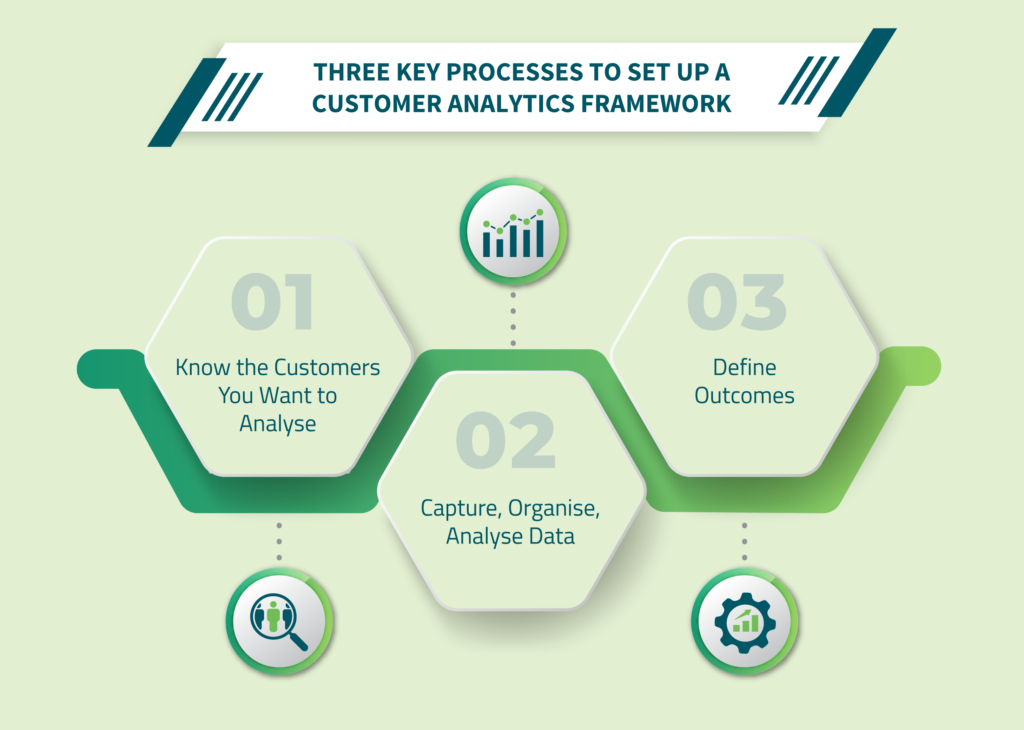
This consistency enables you to accomplish two goals: reduce silos and increase organisational buy-in.
Step 1: Know the Customers You Want to Analyse
Keep in mind the final objective and prior client journeys while developing a customer analytics strategy. Mapping a customer journey can help create a detailed, diagrammatic map of all conceivable phases and points of contact between customer and business.
It begins with brand discovery and ends with post-sales service aimed at repeat purchases.
Ask these questions that help you map the client journey:
- Who are our consumers? What is their age range? Do I have their demographics, general area, and buying capacity?
- Which are the touchpoints that my customers prefer at various phases of the buying journey?
- What makes customers buy from us and not from the competitors?
- How do customers like to communicate with my business?
You may ask more such questions depending on your goals for using your customer analytics framework. A customer journey mapping exercise can help you identify the best touchpoints to collect relevant data from and gaps in the journey that cue missed opportunities to collect such data. Additionally, it helps connect the dots between different touchpoints along the journey, allowing you to draw better conclusions from the data you collect.
Step 2: Capture, Organise, Analyse Data
Once you identify key data you want to collect and the sources from which to get it, the next step involves collecting as much data as possible to meet your objectives. Collect data from a variety of sources like:
- Your website
- In-store visits and purchases
- Email marketing
- Internet browsing
- App activity
- Blog communities
- Social media interactions
- Your CRM tool
Additionally, you may conduct customer surveys, do user research, or acquire third-party data into your consumer analytics framework.
Step 3: Define Outcomes
Building a solid customer analytics strategy will need you to identify the objectives you want to achieve using the data at hand. Determine the analysis you are planning to conduct based on the final results you aim for.
Consider if you intend to get clarity about what occurred (descriptive), why it happened (diagnostic), answers to particular queries and alternative solutions (prescriptive), or what may occur in the future (predictive) as a consequence of the analytics? Defining such outcomes will help you frame the right approach from the beginning as you collect data at the source.
Which data customer analytics can impact your business results?
Business results are the consequence of activities you undertake. Most of your decisions will rely on the data that influences business outcomes. Creating an impact with the right choices would need you to gain enough information about your customers to retain and engage them.
Let us take a look at the four key types of data analytics that can impact your business. Knowing these will help you pivot resources to optimise output.
Review Analysis
Customer reviews echo the sentiment of your users. As a result, they are a valuable source of information you can monitor. Start by analysing the reviews from Google, your social media pages, Yelp, contact centre, among other sources discussed earlier.
Automated big data analytics systems go through all such reviews (qualitative data) to evaluate them for data insights. This is often attributed to sentiment classification, which determines positivity, negativity, or neutrality.
Such technologies analyse data using machine learning algorithms. For example, text analysis is conducted, which is an automated procedure for analysing and extracting information from a piece of text.
Predictive Customer Analytics
Predictive customer analytics gives an in-depth analysis of client behaviour in real-time. Rather than relying on historical data, you may anticipate a certain consumer behaviour using AI and machine learning.
This is a favourable technique in the eCommerce business where customers are buying online. Predictive analytics can collect real-time shopping data and present to you a trend in shopping behaviour. This covers their buying patterns, frequency of purchases, and favourite items which helps forecast the product demands and market sentiment.
Real-Time Product Feedback
Businesses can leverage various data collection models to drive insights into customer behaviour, but nothing trumps real-time product feedback. This could include the use of AI technology to track real-time feedback on customer purchase habits where a website or product may respond in real-time to the demands of its clients.
Many businesses are continuously learning more about their customers’ interests to serve them better. One such use case is that of Spotify. If you listen to music from a particular genre or an artist, you are more likely to listen to that artist or genre in future; or even related artists in the same genre. Incorporating real-time product feedback can help adjust your offerings to suit your customers’ needs better.
Competitor Analysis
A multi-dimensional approach to business growth would require studying the competition as well. This is why competitor analysis is crucial to keep a tab on your competition — goods and services they offer, marketing tactics, and recent market performance. Such data will let you determine how you can improve your products and services by expanding the customer base.
You cannot make quick decisions by simply looking at your business data. Dwelling on the competitor’s data will provide you with a macro-outlook into gaining a new customer base. Competitive analysis is critical for understanding what your rivals are doing and then doing it better. This way, you know customer analytics inside-out, beyond the scope of your business and play by the rules that the market demands to gain a competitive advantage.
Customer Analytics Tools
For your experts to crunch numbers and report useful insights, there are a bunch of customer analytics tools you can use. Start equipping yourself with the right knowledge of such tools along with a robust customer engagement platform to let the data do all the magic.
Take a quick look at some of the powerful data analytics tools to benefit your business.
Acquire
This tool will let you centralise customer contact history. It also helps you access data from multiple channels like live chat, website, social media, and chatbot in one location.
Additionally, Acquire records your team’s activities, like the time taken to respond to client inquiries. This will allow key decision-makers in your business verticals to pivot resources towards more effective methods for better customer service.
Kissmetrics
Kissmetrics is an important tool for eCommerce businesses, but you can also use it for your lead-generating website. It helps analyse user activity throughout your website by looking into which elements bring more conversions. This way, you can identify key digital assets and optimise those to enhance conversion.
Acoustic Insights
IBM Watson Customer experience analytics is now known as Acoustic Insights. This is a handy tool to visualise customers’ journeys.
It will help make the right choices to optimise user experiences, websites and applications. Moreover, engage a small team that can create reports using its real-time dashboard data coupled with its customer data session recording tools.
Hootsuite
Hootsuite analytics enables you to track the effectiveness of your social media channels and get actionable data for potential initiatives.
Google Analytics
It is one of the highly preferred and free-to-use analytics tools. With Google Analytics, you get access to a sophisticated suite of tools for analysing your website’s traffic, activity, and customer journey.
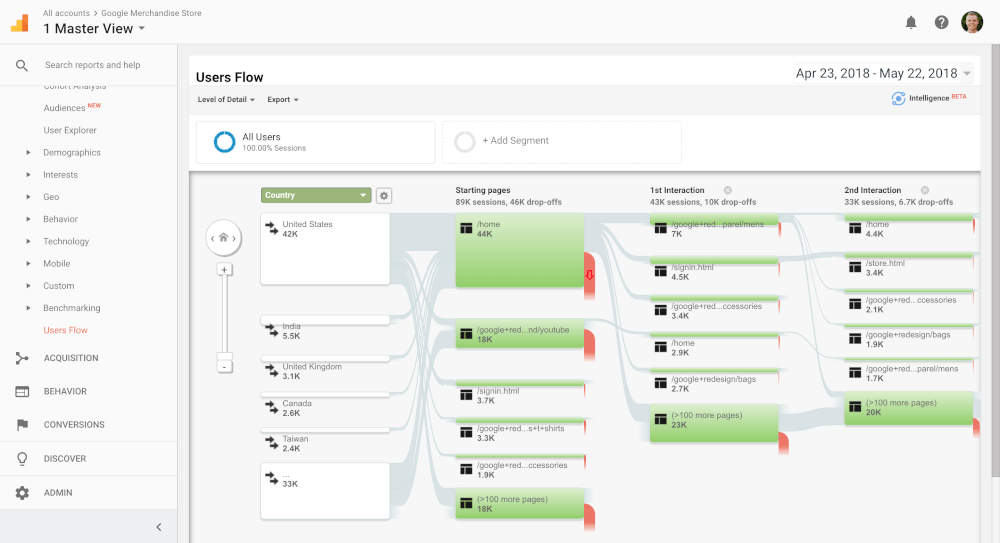
<ahref=”https://images.squarespace-cdn.com/content/v1/572d25ecd210b899879359a5/1527075812005-UU95OJUH8L8T7MAWR6XU/Google+Analytics+Navigation+Paths?format=1000w”>Image Source
Google Analytics connects with Data Studio that offers reporting capabilities that help you see trends and patterns in how their website visitors interact with it. Data gathering, analysis, monitoring, visualisation, reporting, and interaction with other applications are all enabled by features.
Hotjar
Get insights for real-time user interaction on your website as Hotjar offers heatmaps, recordings, and much more to help you learn more about your visitors.
Benefits of Implementing Customers Analytics
The overarching advantage of using customer analytics is the ability to make more informed, meaningful, and timely decisions. Apart from this, consumer analytics provide a plethora of other benefits as follow:
Reduce Customer Churn
You can use customer analytics to address the issue of client attrition quickly. Any analytics-backed insights are bound to comprehend consumer requirements, meet their wants, and keep them pleased. If your business can consistently exceed customer expectations, the chances of customer attrition will come down.
Improve Customer Engagement
Customers actively involved with your business are more likely to engage in repeated purchases. Using customer analytics, you may target product marketing campaigns to the right set of consumers. In addition, the services and goods will be geared toward the needs of your target group. In the end, things will accumulate to increased customer engagement rates that ultimately lead to a positive return on investment (ROI).
Boost Sales
You can impose customer analytics to determine their purchasing preferences and customise their buying experience to drive more sales. Focus on providing a seamless journey without a botch. Taking such measures will increase customer retention and conversion rates. All of these factors will eventually result in higher sales and profit.
Effective ROI of Campaign Expenses
Customer analytics pinpoints the most relevant and receptive audience segment that is more likely to convert into customers. You need to focus on them with targeted campaigns to encourage buying amongst the prospective customers who’ve shown a proven purchase intent (based on data). Such analytical, data-driven spending boosts the ROI of your campaigns.
Concluding Thoughts
Remember, your customers are the real assets, and this is why you need to take good care of them. They are the ones who will end up spreading good word-of-mouth if you provide them with exactly what they are looking for. And you can only do so by implementing the right customer analytics strategy. Gather relevant data from various sources and use the appropriate analytics tools and tactics mentioned above to start using your existing customer base to earn more customers and retain them.
Originally published 28 Jan, 2022, updated 13 Jan, 2023


